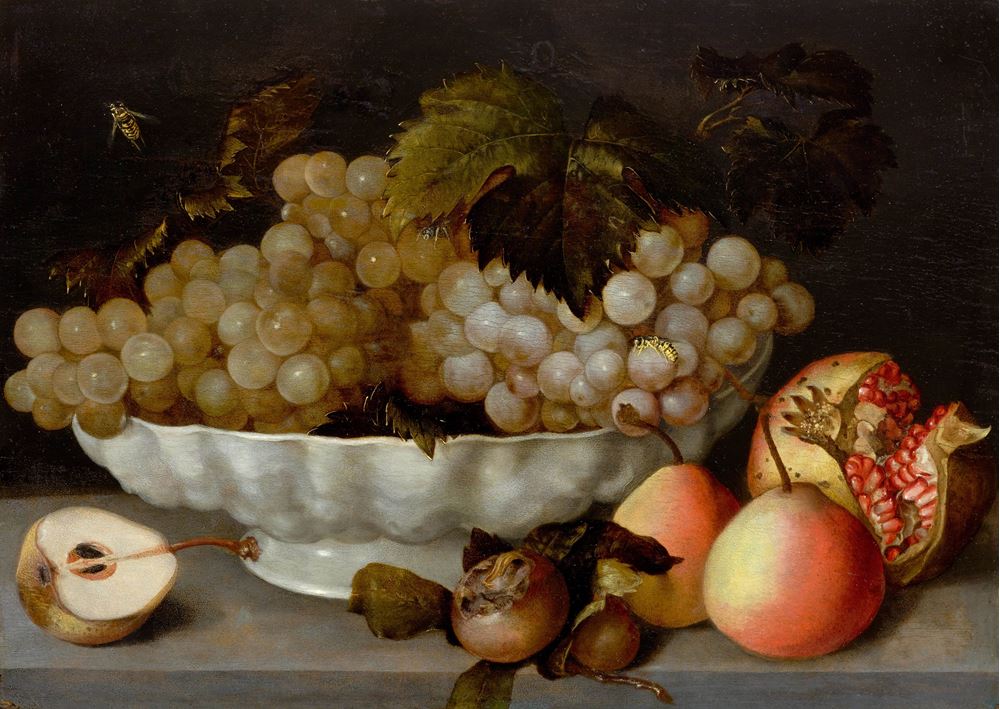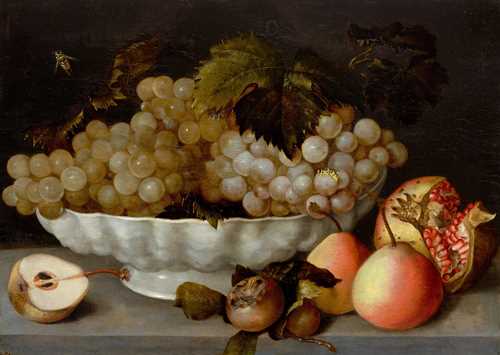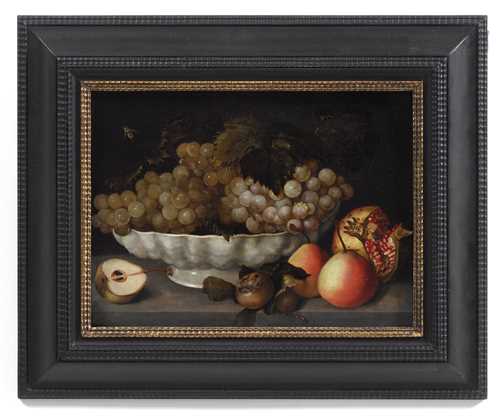
拍品 3018 - A192 大师画作 - Freitag, 19. Juni 2020, 02.00 PM
FEDE GALIZIA
(1578 Milan 1630)
Still life of fruits with grapes in a white ceramic bowl, with pomegranate and pears on a stone plinth.
Oil on panel.
28 × 38.3 cm.
Provenance:
Swiss private collection.
This still life with fruits recently discovered in a Swiss private collection is a high-quality work by the Milanese artist Fede Galizia. Her attention to every detail and her innovative compositional framework are characteristic features of this exceptional artist and are superbly demonstrated here.
Fede Galizia, with her naturalistic, reduced compositions with fruits and flowers, contributed significantly to the establishment of the still life genre in Italy at the beginning of the 17th century. Only around twenty of her still lifes are known to exist today, so that her fruit and flower pieces are a rarity and represent important milestones in the history of art.
Galizia was educated in Milan by her father, the miniaturist Nunzio Galizia (1539–1621) and mention was made of her when she was just twelve years old. The art critic Gian Paolo Lomazzo (1538–1592) reported that Fede studied and imitated the great masters of her time. Although female artists of her time rarely received commissions for history paintings, during her lifetime Galizia was especially known for her devotional paintings and portraits. While most painters in the 17th century specialised in a single genre, Galizia appears to have defied the barriers of the male-dominated art world and created a diverse body of work. While her still lifes were virtually unknown until the 20th century, it is now apparent that Fede Galizia, as did Clara Peeters (circa 1589–1657) in the Netherlands, was to play a decisive role in the emergence of the relatively new genre of still life.
The earliest known example in art history of a still life of fruits is the simple composition with a basket of fruit by Caravaggio (1571–1610), which is in the Pinacoteca Ambrosiana in Milan and is dated between 1595 and 1596. In the early 17th century Caravaggio’s paintings were housed in the collection of Cardinal Federico Borromeo in Milan, together with a series of works by Jan Brueghel the Elder (1568–1625), and it is possible that Fede Galizia was inspired by the intense realism of these works. Galizia’s works, however, exhibit a uniquely calm atmosphere, which is established through the simplicity of the individual elements, and the manner in which the fruits and flowers assume a monumental presence within the smallest space.
Fede Galizia’s precise observation of nature brings to life every single element of this still life. The modulations of light and shade suggest the curve of the vine leaves and the ripeness of the grapes, the refined layers of glaze convincingly convey the texture of the fruits in contrast to the cooler firmness of the white ceramic bowl. The beauty and realism of her composition encourage the viewer to take pleasure in the tiny details and the finesse of their execution. The excellent condition of this small panel, moreover, particularly highlights this piece as a highly accomplished work within Galizia’s oeuvre.
The most recent research has expanded the group of still lifes of fruit by Galizia, which has led to a revival of her popularity and a reappraisal of her significance within Italian Baroque art. So, for example, a previously unpublished composition with grapes in a white ceramic bowl, pears and a pomegranate, comparable to the work presented here, was auctioned a couple of years ago in New York, together with its pair (Sotheby's, New York, 1.2.2018, Lot 20). In his monograph of the artist, Flavio Caroli dates a comparable pair of still lifes to Galizia’s late period (see Flavio Caroli: Fede Galizia, Turin 1989, p. 88, Cat. No. 34 and 35). Caroli also mentions an almost identical still life with grapes in a white ceramic bowl, pears and a pomegranate, which is in a Milanese private collection (see Flavio Caroli: Fede Galizia, Turin 1989, p. 94, Cat. No. 62).
Our thanks to Prof. Mauro Natale and Prof. Alessandro Morandotti who have recently confirmed the authenticity of this painting having examined it in the original. This painting was not known to Caroli in 1989.
Swiss private collection.
This still life with fruits recently discovered in a Swiss private collection is a high-quality work by the Milanese artist Fede Galizia. Her attention to every detail and her innovative compositional framework are characteristic features of this exceptional artist and are superbly demonstrated here.
Fede Galizia, with her naturalistic, reduced compositions with fruits and flowers, contributed significantly to the establishment of the still life genre in Italy at the beginning of the 17th century. Only around twenty of her still lifes are known to exist today, so that her fruit and flower pieces are a rarity and represent important milestones in the history of art.
Galizia was educated in Milan by her father, the miniaturist Nunzio Galizia (1539–1621) and mention was made of her when she was just twelve years old. The art critic Gian Paolo Lomazzo (1538–1592) reported that Fede studied and imitated the great masters of her time. Although female artists of her time rarely received commissions for history paintings, during her lifetime Galizia was especially known for her devotional paintings and portraits. While most painters in the 17th century specialised in a single genre, Galizia appears to have defied the barriers of the male-dominated art world and created a diverse body of work. While her still lifes were virtually unknown until the 20th century, it is now apparent that Fede Galizia, as did Clara Peeters (circa 1589–1657) in the Netherlands, was to play a decisive role in the emergence of the relatively new genre of still life.
The earliest known example in art history of a still life of fruits is the simple composition with a basket of fruit by Caravaggio (1571–1610), which is in the Pinacoteca Ambrosiana in Milan and is dated between 1595 and 1596. In the early 17th century Caravaggio’s paintings were housed in the collection of Cardinal Federico Borromeo in Milan, together with a series of works by Jan Brueghel the Elder (1568–1625), and it is possible that Fede Galizia was inspired by the intense realism of these works. Galizia’s works, however, exhibit a uniquely calm atmosphere, which is established through the simplicity of the individual elements, and the manner in which the fruits and flowers assume a monumental presence within the smallest space.
Fede Galizia’s precise observation of nature brings to life every single element of this still life. The modulations of light and shade suggest the curve of the vine leaves and the ripeness of the grapes, the refined layers of glaze convincingly convey the texture of the fruits in contrast to the cooler firmness of the white ceramic bowl. The beauty and realism of her composition encourage the viewer to take pleasure in the tiny details and the finesse of their execution. The excellent condition of this small panel, moreover, particularly highlights this piece as a highly accomplished work within Galizia’s oeuvre.
The most recent research has expanded the group of still lifes of fruit by Galizia, which has led to a revival of her popularity and a reappraisal of her significance within Italian Baroque art. So, for example, a previously unpublished composition with grapes in a white ceramic bowl, pears and a pomegranate, comparable to the work presented here, was auctioned a couple of years ago in New York, together with its pair (Sotheby's, New York, 1.2.2018, Lot 20). In his monograph of the artist, Flavio Caroli dates a comparable pair of still lifes to Galizia’s late period (see Flavio Caroli: Fede Galizia, Turin 1989, p. 88, Cat. No. 34 and 35). Caroli also mentions an almost identical still life with grapes in a white ceramic bowl, pears and a pomegranate, which is in a Milanese private collection (see Flavio Caroli: Fede Galizia, Turin 1989, p. 94, Cat. No. 62).
Our thanks to Prof. Mauro Natale and Prof. Alessandro Morandotti who have recently confirmed the authenticity of this painting having examined it in the original. This painting was not known to Caroli in 1989.
CHF 150 000 / 200 000 | (€ 154 640 / 206 190)
以瑞士法郎銷售 CHF 451 700 (包含買家佣金)
所有信息随时可能更改。


